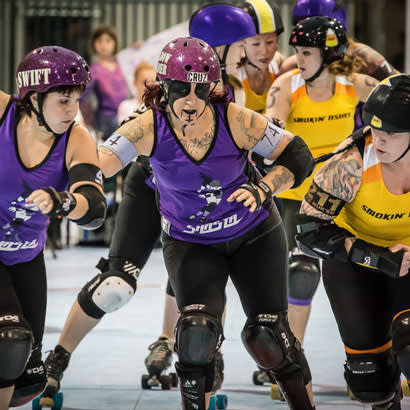
The Women’s Flat Track Derby Association (WFTDA), led by an international team of public health professionals including Bubble Wrath, Trauma, BG Smack (derby names) and others, has put together one of the most comprehensive return-to-play plans in sports. The WFTDA COVID-19 Guidelines to Return to Roller Derby was developed to guide roller derby leagues in any geographic area through a safe return to play when allowed to do so by local government and public health officials. The document is being touted as one of the most detailed and public health-minded set of guidelines, leading league organizers through a slow and phased return to full contact, protecting the health and well-being of players, officials and spectators throughout the process.
The resource provides clear indicators that should be met prior to moving through each of the seven phases, taking into account equity and access, hospital admissions, percent of positive tests, and COVID-19 related deaths. Policy recommendations including checking symptoms, using face coverings, and having a reporting structure and policies for requiring isolation are included, as well as activity recommendations including conditioning, drills, in-house scrimmages, inter-league play, allowance of spectators, small events, and travel. Each section also identifies indicators that may require a step back to a previous phase to protect the health and safety of players, officials and spectators.
In reviewing the guidance, there are several key takeaways and best practices that we can borrow from the WFTDA when planning for resuming other contact sports (although, roller derby seems like a pretty fun opportunity for parks and recreation to be involved in):
- Establish a cross-sector task force with expertise in public health, healthcare, equity, sports (players, coaches, officials and caregivers) and other priority areas represented. Diverse expertise and perspectives will be needed to think through all aspects of a return to play, translate existing public health guidance into practical strategies, and ensure that all voices are included in the planning process.
- Outline and publish clear conditions that must be met within your local community prior to moving into the next phase and clear indicators that will demand a pause in progression or a return to previous phases. Conditions should be monitored frequently and include local public health data, changes in local government regulations, and tracking of cases in your league to inform decision making.
- In each phase outline clear policy guidance and activity guidance for the specific sport. Policy guidance should include things like face covering requirements, limits on equipment sharing, cleaning and disinfection practices, and limits on spectators. Activity guidance should outline the specific sports-related activities that would be allowable in each phase including non-contact drills, contact drills, team scrimmages, inter-league play, travel outside of the local community, etc.
- Ensure that in moving through phases all players will have equitable access to participate. For example, consider the impact of public transportation closures or alternate schedules on players who may rely on public transit to get to practices and games. It’s also important to recognize the economic impact that COVID-19 may have had on players and their families and make accommodations as needed.
- Focus on conditioning and injury prevention when resuming play. With the temporary suspension of many sports and other physical activity opportunities, players and officials will need to spend time reconditioning and reacclimating their bodies to play to reduce the risk of injury. In high heat areas where practices may be occurring outside, ensure that your taking preventative measures to prevent heat-related illness.
- Have a clear plan in place for how to manage a positive case among players, officials or spectators. This should include guidance on self-isolation, contact tracing, pausing play, etc.
- While it may seem like a long path forward, it is critical to move slowly, building in the time for implementing each phase and monitoring for any changes in local conditions on the ground or direct impacts to your program that will call for reevaluating.
And lastly, a best practice we can all take away from this resource and the process of creating it is that it is a lot more fun if you have really cool derby names.
Allison Colman (Derby name: Cheesemonger) is NRPA’s Director of Health.

